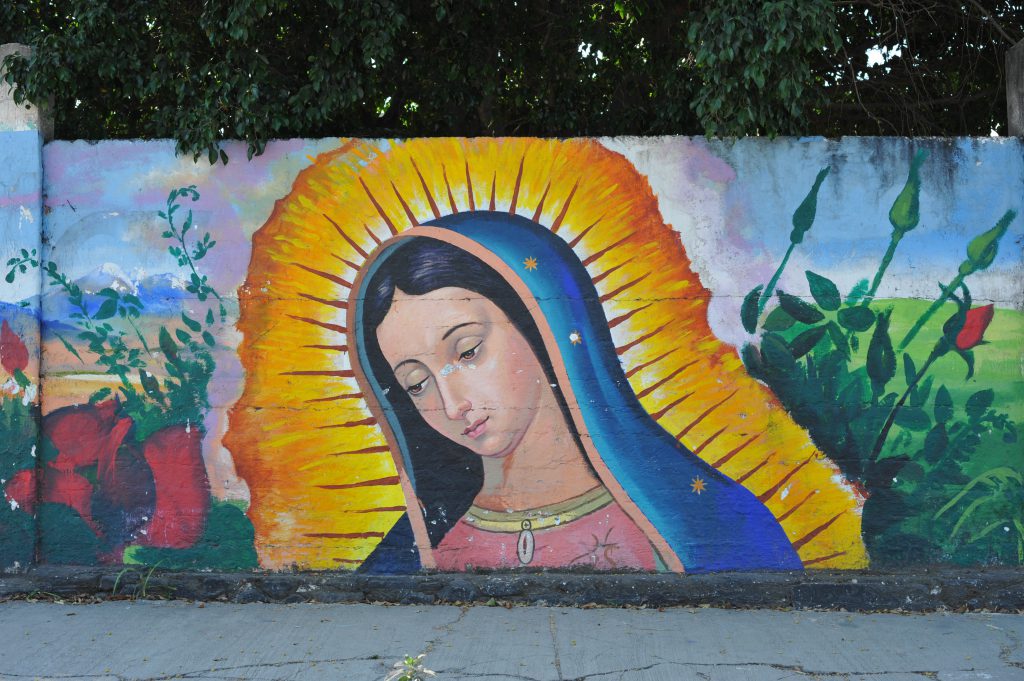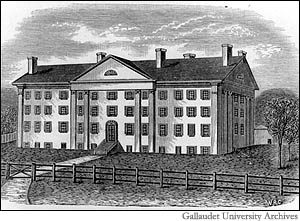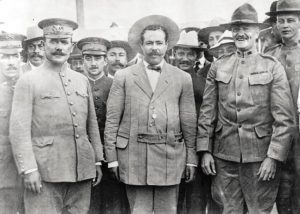Imagine waking up one day and going about your regular routine, when suddenly something happens that will not only change your life but the lives of Catholics and Mexicans forever.
At dawn on December 9, 1531, Juan Diego, who was a young Aztec Indian from the village of Cuautitlán, was on his way to attend weekly mass at the Franciscan church at Tlatelolco. He had recently converted to Catholicism, and the church was a few miles away from his uncle’s house, where he lived at after the death of his parents. While taking a shortcut over the hill of Tepeyac, he heard his name being called, and at the same time he heard music and the singing of birds.1 He followed the sounds and heard someone calling to him from the peak of the hill, “Juanito, Little Diego.” When he reached the top of the hill, he saw a young lady standing there who motioned for him to come closer: “Juanito, the smallest of my sons, where are you going?” He answered: “My Lady and my child, I have to go to your house in Mexico, Tlatelolco.” She declared herself to be “the eternal Virgin, holy Mother of the true God” and “merciful Mother” of men.2 She told Juan Diego to go to the bishop of Mexico, the Spaniard Fray Juan de Zumarraga, and tell him that she wished to have a church built on the hill of Tepeyac.3 This was the start of a life-changing moment for Juan Diego and soon, for Catholics all over the world.

Later that day, Juan Diego made his way to the bishop’s palace, which was about four miles away, and after some difficulty with the guards, he was eventually admitted to the bishop’s study, and he delivered the message from the Virgin Mary and told him everything that he admired, saw, and heard.4 The Bishop answered: “You will come again, my child, and I will think about the message you have brought.”5 Zumarraga was sympathetic but not convinced by the story that Juan Diego told him. As the first Catholic bishop of Mexico, he had heard many wild stories from converted Indians, and needed more time to think about it. In the recent decade, the colony of New Spain had been established after Hernan Cortes conquered the Aztecs in 1521. One of the goals of the Spanish was to convert the native indigenous population to Christianity. However, this was a very slow process. In many areas, the old religious practices were still being maintained a decade later. Some of the beliefs of the natives were incorporated into their own form of Christianity.6 Juan Diego left the bishop’s palace feeling very sad and returned to the hill where he had previously seen the Virgin, and explained to her what happened with the bishop, and suggested that it would be a better idea for her to send someone more important than he was to the bishop. The Virgin reassured him that he was the chosen one, and directed him to visit the bishop again the following day.7
The next day, on December 10, Juan Diego returned to the bishop’s palace and asked him if they could build the church for the Virgin Mary. The bishop asked him many questions in order to test his truthfulness, such as where he had seen her and how she looked, and Juan Diego answered everything precisely to the bishop.8 The bishop listened carefully but said he would need some proof before building a church for her. He directed Juan Diego to bring back an unmistakable sign for the validation of the apparitions that occurred. After Juan Diego left, the bishop then sent two of his staff to follow him and report back what they had seen. Juan Diego went back to the hill at Tepeyac and the staffers that were following him lost sight of him and returned back to the bishop’s palace. Meanwhile, Juan Diego had seen the Virgin Mary again, and told her the answer that the bishop had given him. She told him to come back the following day and she would give him a sign for the bishop.9
When he returned home, Juan Diego found his uncle, Juan Bernardino, seriously ill and at the point of dying. He nursed him all through the night. In the morning, he decided to call on a priest from the church at Tlatelolco to administer the last rites, as his uncle’s health was not improving. Juan Diego was worried that he had failed to meet with the Virgin Mary, and took the longer and lower road to Tlatelolco instead of the shortcut over the hill of Tepeyac. But the Virgin appeared on the lower path and told him that there was no need to worry about his uncle Bernardino, whom she had visited and was now cured. She then told Juan to go back to the top of the hill, where he would find many flowers growing. His mission was to pick a bunch of the flowers, wrap them in his cloak, and take them to the bishop. The Virgin stressed that these flowers must be concealed and not shown to anyone else.10

The top of the hill was not a place where flowers would usually grow, because of thorns, thistles, cactus, and small weeds. And it was the month of December, when everything is killed by the frost. However, he found some beautiful and fragrant roses growing, so he picked a bunch, wrapped them in his cloak, and headed down towards the Virgin to show her what he had discovered. The Virgin took them in her hands and told him that this bunch of flowers was the proof that he needed to show the bishop, and in showing him, the bishop would believe all that Juan Diego had said.11 He picked up the bunch of flowers, wrapped them in his cloak, and headed towards the bishop’s palace one last time, and upon arrival, the guards demanded to know what he was carrying in his cloak. The guards could smell the flowers and when they opened the cloak, the roses were fresh, fragrant, fully open, and precious. They took the cloak away from Juan and attempted to grab some of the flowers, but once they had opened it again and reached to grab some, the roses had become painted flowers on the inside of the cloak. They took Juan to the bishop and when he unfolded his white cloak to the bishop, the fresh roses spilled out onto the floor. When the various roses fell on the floor, the bishop saw that on the inside of the cloak where the flowers once had been, a portrait of the Virgin Mary appeared.12

When the bishop and all that were present saw this image, they fell to their knees in admiration. The bishop took the cloak to his chapel, where he then prayed and thanked God and the Virgin for the miracle. The bishop, astounded by this miracle, asked to be taken to where Juan Diego had seen the Virgin Mary. Upon arrival at the hill of Tepeyac, the bishop ordered that the church that the Virgin Mary had requested to be built would indeed be built, and would be named “The Basilica of Our Lady of Guadalupe,” which is located in present-day Mexico City. The cloak with the picture of Our Lady of Guadalupe can be found at this church that was built in her honor.13
It has been said that the dark-skinned image of Mother Mary as a virginal Native American girl helped the Spanish priests convert millions of Mexican Indians to Catholicism.14 Occasionally, we encounter a symbol that seems to enshrine the major hopes and aspirations of an entire society. Such a master symbol is represented by the Virgin of Guadalupe, Mexico’s patron saint. Her image was not only used during wars and battles as a figure of protection, but is also still used to adorns house fronts, churches and home altars, restaurants, and so much more. Her shrine at Tepeyac is visited each year by hundreds of thousands of pilgrims that all go to honor her.15 To the present day, Our Lady of Guadalupe remains a powerful symbol of Mexican identity and faith, and her image is associated with everything from motherhood to feminism to social justice. Her image has often graced the banners of those struggling for Mexican independence, and she has been understood by many devotees to side with oppressed and poor people. Mexican immigrants to the United States brought with them their devotion to her—privately and affectionately called “La Morenita”—and have helped to perpetuate her identification with others.16 After the apparitions of the Virgin Mary occurred, many Catholics began to honor her and see her as their own mother, especially Mexicans since they often refer to her as “nuestra Madre” or “Our Mother” and adopted her as their own. The feast of Our Lady of Guadalupe is celebrated every December 12, which became a national holiday in Mexico in 1859, and she has been recognized as the patron saint of Mexico.17

- Encyclopedia of Occultism and Parapsychology, 2001, s.v. “Guadalupe Apparitions (of the Virgin Mary)”, by J. Gordon Melton. ↵
- Samuel Marti, The Virgen of Guadalupe and Juan Diego (Ediciones Euroamericanas, 1973), 36-38. ↵
- Encyclopedia of Occultism and Parapsychology, 2001, s.v. “Guadalupe Apparitions (of the Virgin Mary)”, by J. Gordon Melton. ↵
- Encyclopedia of Occultism and Parapsychology, 2001, s.v. “Guadalupe Apparitions (of the Virgin Mary)”, by J. Gordon Melton. ↵
- Samuel Marti, The Virgen of Guadalupe and Juan Diego (Ediciones Euroamericanas, 1973), 39. ↵
- Global Events: Milestone Events Throughout History, 2014, s.v. “The Virgin of Guadalupe Appears to Juan Diego”, by Jennifer Stock. ↵
- Encyclopedia of Occultism and Parapsychology, 2001, s.v. “Guadalupe Apparitions (of the Virgin Mary)”, by J. Gordon Melton. ↵
- Samuel Marti, The Virgen of Guadalupe and Juan Diego (Ediciones Euroamericanas, 1973), 43. ↵
- Encyclopedia of Occultism and Parapsychology, 2001, s.v. “Guadalupe Apparitions (of the Virgin Mary)”, by J. Gordon Melton. ↵
- Encyclopedia of Occultism and Parapsychology, 2001, s.v. “Guadalupe Apparitions (of the Virgin Mary)”, by J. Gordon Melton. ↵
- Samuel Marti, The Virgen of Guadalupe and Juan Diego (Ediciones Euroamericanas, 1973), 48. ↵
- Encyclopedia of Occultism and Parapsychology, 2001, s.v. “Guadalupe Apparitions (of the Virgin Mary)”, by J. Gordon Melton. ↵
- Global Events: Milestone Events Throughout History, 2014, s.v. “The Virgin of Guadalupe Appears to Juan Diego”, by Jennifer Stock. ↵
- The Gale Encyclopedia of the Unusual and Unexplained, 2003, s.v. “Virgin of Guadalupe,” by Brad Steiger and Sherry Hanson Steiger. ↵
- Eric R. Wolf, “The Virgin of Guadalupe: A Mexican National Symbol,” The Journal of American Folklore 71, no. 279 (1958): 1. ↵
- Contemporary American Religion, 1999, s.v. “Virgin of Guadalupe,” by Sandra L. Zimdars-Swartz. ↵
- Contemporary American Religion, 1999, s.v. “Virgin of Guadalupe,” by Sandra L. Zimdars-Swartz. ↵



103 comments
Jared Sherer
The article about Juan Diego and Our Lady of Guadalupe was interesting to read and I learned many details about how the Catholic Faith in Mexico changed. The story about Juan Diego and his encounter with the Virgin of Guadalupe was very intriguing and a joy to read. Ms. Ortiz weaves together a story rich in details, showing solid research and an excellent feel for her subject. It was very well researched and presented in a thoughtful and organized manner. I enjoyed the imagery used throughout her text for the reader to understand and imagine what Juan Diego had to go through. The article was very descriptive and detailed, especially about the flowers that Juan Diego had to pick out and take to the priest in order for him to believe the young boy, and what he had to go through to be believed.
Jacob Salinas
What an amazing article to read! It was super fascinating reading about Juan Diego’s encounter with the Virgin Mary. I have heard stories about Juan Diegos encounter with the Virgin Mary as a little boy. This story is very important to me and my family being that we are catholic. Our Lady of Guadalupe is a very important figure for Catholics and Mexicans. Juan Diegos encounter just reaffirms what people continue to believe.
Christopher Morales
You told this story very well. I have heard it sense I was a little boy from my grandma who told it in Spanish. Being in this class, I recognized and put the history of your article along with the time which the Aztecs were being conquered by cortes. The image is an image I have seen all my life and a symbol of reverence for my family. This is the impact you were talking about. On that day, all those years ago, that event impacted my Hispanic Catholic family today. You told the events in a great order that really demonstrated the beauty of it and recognized the different factors or forgiveness for missing the meeting and the healing of his uncle.
Barbara Ortiz
I really enjoyed reading your article. Since moving to Texas, and raising my kids in the southwest, I am enjoying sharing my heritage and culture with them. While I knew of Juan Diego and his visions, and his tilma (still on display in the Basilica), I did not know of the miracle of his uncle being cured nor that his uncle had also seen the Virgin. It is interesting to read and know the impact that it had on the conversions for years to come.
Gabriella Parra
I’m surprised I’ve never heard the story of the Virgin of Guadalupe before even though I’ve always seen her image. I found it interesting that the Virgin was depicted as a young Native American girl in order to appeal to the indigenous population. It’d be interesting to hear conversations between Spanish bishops talking about how to make Catholicism appeal to natives.
Eugenio Gonzalez
The article was informative because it explains the cultural importance of the Virgin of Guadalupe in Mexican culture. I like how the author tells the story of Juan Diego and the image that he saw. The author does an excellent job of using images that help the reader understand the importance of Juan Diego and the Virgin of Guadalupe in catholicism.
Melyna Martinez
This article I think showcases the importance of La Virgen de Guadalupe for Mexican culture and faith. Mexicans draw her and Juan Diego’s story that in a way helps shape Mexican culture as well as root catholicism into it. I believe Juan Diego’s story was one of the first that inspired people, and use the Virgin as a symbol to represent and go against the stereotypical white normatime of religious icons.
Noelia Torres Guillen
I was raised in a household were we adored La Virgin de Guadalupe. The story of Juan Diego is a popular and well-known story. La Virgin de Guadalupe is seen as the mother and protector of mestizos. That’s why she’s an important aspect of Mexican culture. It is very interesting how in order to get the indigenous peoples to convert to Catholicism they added aspects of their own goddess Tonantzin, mostly because the siting of La Virgin de Guadalupe was were a temple of Tonantzin was previously located. Good work!
Lucia Rogel
This is a great article! I appreciate the accuracy of the details and the simultaneous simplicity of the story. I was raised in the Catholic faith, and my family always put together a theatrical act of this event every 12th of December and throughout the posada period. We performed at the missions in San Antonio and other parishes throughout the city. Though I was already familiar with the event, just now I realize the impact of representation that the Virgin Mary had on the native groups that persisted in Mexico. It’s often easy to assume that the way we see an important figure, especially in religion, is not the same figure that the rest of the world knows it as. Just like a more relatable figure that Mexico adores, other parts of the world that were introduced to Christianity by the Spanish have their own figure whom they also adore and praise. Even if that figure does not exactly look like Mexico’s version, or the Spaniards’.
Luke Rodriguez
Throughout my whole life, I have heard the story of Juan Diego from my family and at school because I have gone to a Catholic school my whole life, and I have never forgotten that story. So to learn more about the story, like these details. But then it is a major story because it teaches about the Lady of Guadalupe.